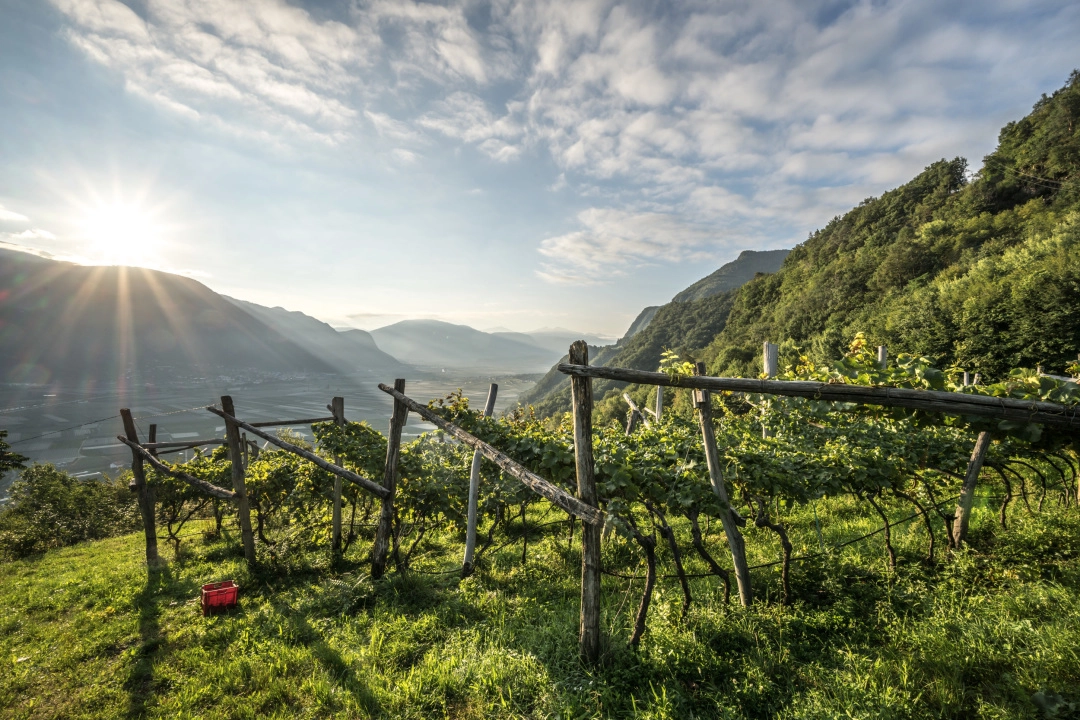In partnership with Serendipity, the following wine is available in California and Texas markets.
In the summer of 2024 our National Imports Division took a team of sales reps to visit one of Italy’s smallest and most secluded wine regions: Alto Adige. Their ultimate destination? The historic Nals Margreid winery in South Tyrol. Despite a handful of hiccups, one blown-out tire and a few perilous mountain passes later the team arrived for an inspirational day of good wine, good food, and great people. These were their top takeaways from the trip— some of which confirmed what we already knew about this region, and others that hit us like an unexpected breath of fresh, Alpine air.
Lush Topography
“My biggest take away from Alto Adige was how lush the area in and around the vineyards were. Also, the amount of Golden Delicious Apple trees…I knew Alto Adige was going to be a cool climate region, but I was still surprised at how green the vineyards and overall area were.” —Michael
Palm trees, apples, and cherries might not be the first thing you think of when you picture Alto Adige, but in-person, this flora runs abundant. The Nals Margreid winery itself lives in close proximity to both the Alpine and Dolomite mountain ranges. Ample rainfall and meltwater from snow-capped mountains means that irrigation is consistent, if not abundant. Dense forests and alpine meadows, not to mention vineyards, benefit largely from this watershed life and result in the lavishly green landscapes we’ve come to associate with South Tyrol.
Such Great Heights
“For me driving in from the North and Switzerland, you get a sense of the difficulty of just producing wine here. The steepness of the roads in and seeing vineyards on hillside slopes that you might not want to even stand on gives you a perspective of what the region can produce and the challenges these farmers must undertake to grow grapes and produce world class wine… And the most surprising thing to me was the significant elevation differences of where the single vineyards were. Planting by varietal based upon elevation (and thus its own micro climate) was really enlightening. I believe there was a difference of nearly a half mile of vertical gain between their lowest and highest vineyards.” —Matt
Elevation plays a huge role in the viticulture at Nals Margreid. Lower elevations, with their warmer temperatures, are ideal for growing fuller-bodied red wines such as Lagrein and Schiava, while higher elevations provide the cooler conditions necessary for producing aromatic whites like Pinot Grigio, Sauvignon Blanc, and Gewürztraminer. The steep, terraced vineyards are meticulously managed to maximize sun exposure and drainage, resulting in wines that are celebrated for their freshness, acidity, and distinct mineral qualities. This interplay of altitude and climate in Alto Adige’s wine-growing areas contributes to the exceptional diversity and quality of its wines.
Strength in Numbers
“My biggest takeaway from visiting Nals was how the tradition of the co-op is at the heart of the winery operation. 120 individual growers make up 160 hectares of their production… We had the pleasure of being hosted by Hannes Geiser, who has worked for the winery for 20 years. His father owns 2 hectares of vineyards that he farms for Nals. It was great to see someone who grew up in a family farming for the co-op believe in the integrity of the winery and operation that he has spent his career selling the final product of so many family vineyards.” —Karen
Italy has more wine co-ops than any other region in the world. For many, it is a necessity. The benefits of a co-op model include shared resources, economic stability and a greater chance at implementing sustainability practices. Even more powerful is the sense of community co-ops foster generation after generation. At Nals Margreid (which, mind you, goes back to 1764), the ratio of growers to land means that the average farmer is in charge of around just 1.3 hectares. And for those that tout terroir, this is the jackpot! Nals Margreid focuses on tiny parcels, often planted to a sole varietal on a dominant soil type.
Revelatory Wines
The portfolio at Nals Margreid is as vast as it is uniquely committed to site specificity. Each label is distinguished by either a vineyard or bears the name of a singular soil type. ‘Kalk’ Chardonnay, for instance, references chalk soils, while ‘Jura’ Pinot Noir is shorthand for ‘Jurassic’. We currently carry sixteen expressions from Nals Margreid and most of those bottlings are also single varietal expressions. A testament to the diversity of the Nals book, everyone from our team had their own favorites. Scroll to view their top picks:
Our journey to Nals Margreid in Alto Adige was a profound exploration of a region where nature and tradition intertwine to create exceptional wines. The lush, green landscape, shaped by the region’s dramatic elevation changes and abundant water sources, offers a stunning backdrop to the meticulous viticulture practiced at the winery. The cooperative model at Nals Margreid not only fosters a sense of community among the 120 growers but also enhances the quality and sustainability of their wines. Each bottle, meticulously crafted from distinct vineyard sites and soil types, reflects the unique terroir of Alto Adige, making every sip a revelation of the region’s rich heritage and innovative spirit.








